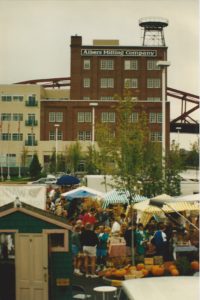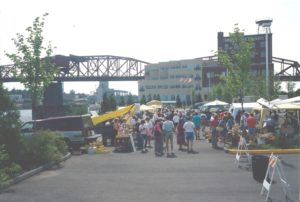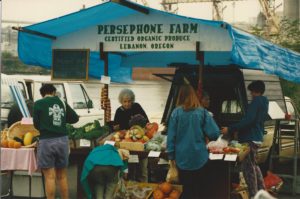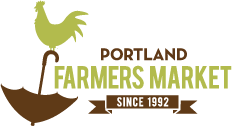Farmers are at our core – they are our reason for being. In 1992, thirteen of them set up shop in a parking lot beside the Willamette River, by the historic Albers Mill. What activists and market founders Craig Mosbaek, Ted Snider and Richard Hagan started has grown and flourished year upon year to represent the 240-plus farmers and food artisans who currently sell at our markets.
People come to our markets to fill their bellies and shopping bags but they also come for fun – live music, vibrant programming, and engaging events. So to celebrate this important milestone we would like to invite all shoppers to our 25th anniversary party of Portland Farmers Market at our PSU Farmers Market on Saturday, July 16. The event will replace our weekly market programming – Kids Cook and Chef in the Market will return July 23, and will provide fun for all ages.
Vendors will be providing special product samples (while supplies last), market staff will be hosting a photo booth and lawn games, and there will even be a live talk show from 10 to 11 am. Host Allison Jones will talk with guests Karen Brooks of Portland Monthly Magazine and farmer Jamie Kitzrow from Spring Hill Organic Farm.
We will also invite shoppers to share their favorite farmers market memory or write a message to their favorite vendor at our “Memory Lane” booth.
To prepare for this event, our staff has been digging up old photos and other memorabilia from years past to paint a picture of what the last 25 seasons have looked like. We recently came across this article, published by Jim Dixon, then a freelance writer and now PFM vendor and owner of Real Good Food in Willamette Week. It describes what Portland Farmers Market looked like that very first season, way back in 1992:
Portland’s New Farmers Market

The city dweller may feel uncertain when it comes to supporting sustainable agriculture. It seems like the organic produce in the natural foods store always costs so much more, making it a “politically correct” purchase available only to the well-heeled. And don’t those same stores carry imported produce in the winter?
While it’s often true that “natural foods” marketing includes some contradictory messages, outlets such as Nature’s, Food Front, People’s, and Happy Harvest are often the only source for locally produced food. Going to the country, whether to shop the roadside stands or pick it yourself, isn’t an option for everyone. Farmers markets fill the gap.
Getting up in the wee hours, hauling the produce into town, and setting up shop is an old tradition for farmers around the world. Nearly every American city once had a thriving farmers’ market, typically a warren of noisy stalls offering everything from fresh-picked vegetables to live chickens. The industrialization of agriculture began with the dust bowl. After WWII, interstate highways, supermarkets, and the quest for “convenience” doomed the farmers’ market as hopelessly quaint and in the way of progress.
In the past, Portlanders have had to settle for markets in the outlaying ‘burbs. That changed this summer with the premiere of the Portland Farmer’s Market at Alber’s Mill. Craig Mosback says he started the market because “I like the market atmosphere, meeting and talking with the farmers, and I like getting people down here to see where the food is from.”

Occupying a corner of the old mill’s new parking lot, the bright blue and yellow plastic tarps strung up by the vendors as cover from the rain and sun make it look as though a low-budget circus has come to town. Even the mood is festive, as shoppers eye the produce and cut flowers that spill from tailgates onto makeshift counters. The growers hawk samples of cucumbers and blueberries like carnival touts and offer advice on preparing fresh corn.
Lindsay Bradshaw represents the Oerther Family Farm, an all-organic farm near Clackamas that he describes as “a loose family operation.” He’s selling summer squash, garlic, cucumbers, and fresh herbs. The Peruvian purple potatoes, gnarled, thumb-sized tubers the color of grape jam, come from rootstock obtained, says Bradshaw, “from an old hippy named Johnny Lovewisdom who started a farm commune in Ecuador in 1947.” It’s information like this that you won’t get at Safeway.

Down the way, a table is covered with bright green moss so that it resembles the floor of an old-growth forest deep in the Coast Range. Piled on top of the moss sit creamy white oyster mushrooms, darkly-mottled matsutake fungus as big as your fist, and dusky orange chantarelles, their inverted gills looking like umbrellas caught in the wind. Bags of dried morels resemble miniature coral, and dried boletus—the Italian’s porcini—exude an enticing aroma. Lars Norgren’s Peak Forest Fruit offers wild mushrooms as well as red and blue beach huckleberries. Norgen himself is full of information and willing to share it.
Among the 20 or so other stands you’ll find long, Kentucky Wonder beans mottled with green and purple; red and yellow, round and pear-shaped tomatoes; strangely bulbous Kohlrabi, looking like tiny, tentacled alien beings; bouquets of multi-colored statice and long gladiola stems; potatoes—Yukon gold, Norwegian blue and plain red besides the Peruvian purple; tart tomatilloes with papery husks; muskmelon, yellow-bellied watermelon, and cantaloupe; resh local rabbit, cut into hindquarters and tenderloins and made into Italian, curry, and cranberry-nut sausage; garlic, by the single head or in long braids, alone or with tiny red peppers; shinseiki and hosui pears, crisp, mild, and looking more like apples; white and yellow corn picked just a few hours ago; sweet green bell peppers, hot green and red jalapenos, incendiary pencil-thin yatsafusa chilis, montegas, cubanelles, anaheims, and anchos.
While some of the shoppers are clearly curious as to what’s going on here along the river, others come with a clear purpose. “I wouldn’t make it out their farms to buy produce in the small quantities that I want, but I can do it here,” said Jean Rystron, loaded down with tomatoes and cucumbers. And some do understand the notion of sustainable agriculture. Sara Packer, explaining that all three generations of her family enjoyed the experience of shopping at the Farmers’ Market, added that she also comes “to support small farmers rather than agribusiness.”
